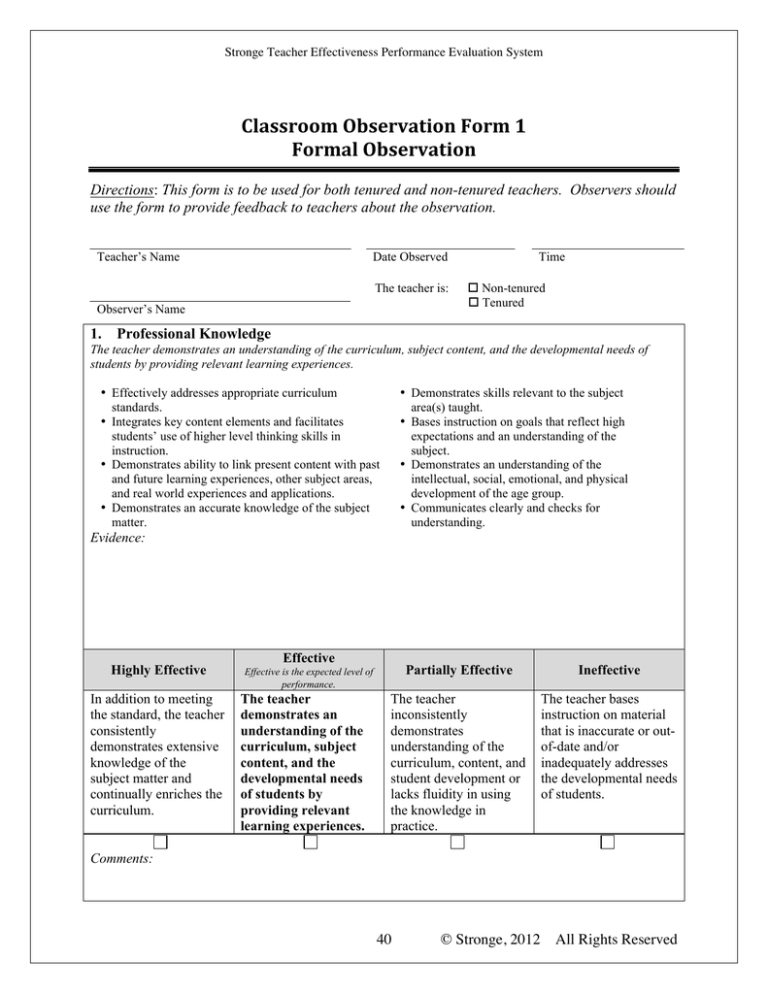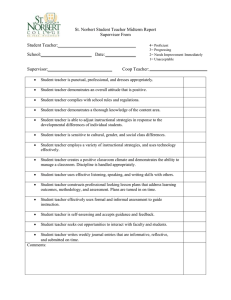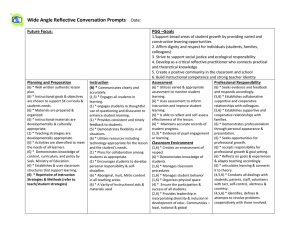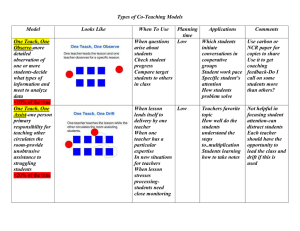
Stronge Teacher Effectiveness Performance Evaluation System
.
/4)''",,5.%&'#"()*+,-.6,"5.7.
6,"5)4.%&'#"()*+,-..
Directions: This form is to be used for both tenured and non-tenured teachers. Observers should
use the form to provide feedback to teachers about the observation.
Teacher’s Name
Date Observed
The teacher is:
Observer’s Name
1.
Time
! Non-tenured
! Tenured
Professional Knowledge
The teacher demonstrates an understanding of the curriculum, subject content, and the developmental needs of
students by providing relevant learning experiences.
• Effectively addresses appropriate curriculum
standards.
• Integrates key content elements and facilitates
students’ use of higher level thinking skills in
instruction.
• Demonstrates ability to link present content with past
and future learning experiences, other subject areas,
and real world experiences and applications.
• Demonstrates an accurate knowledge of the subject
matter.
• Demonstrates skills relevant to the subject
area(s) taught.
• Bases instruction on goals that reflect high
expectations and an understanding of the
subject.
• Demonstrates an understanding of the
intellectual, social, emotional, and physical
development of the age group.
• Communicates clearly and checks for
understanding.
Evidence:
Highly Effective
In addition to meeting
the standard, the teacher
consistently
demonstrates extensive
knowledge of the
subject matter and
continually enriches the
curriculum.
Effective
Partially Effective
Ineffective
The teacher
inconsistently
demonstrates
understanding of the
curriculum, content, and
student development or
lacks fluidity in using
the knowledge in
practice.
The teacher bases
instruction on material
that is inaccurate or outof-date and/or
inadequately addresses
the developmental needs
of students.
Effective is the expected level of
performance.
The teacher
demonstrates an
understanding of the
curriculum, subject
content, and the
developmental needs
of students by
providing relevant
learning experiences.
Comments:
40
© Stronge, 2012
All Rights Reserved
Stronge Teacher Effectiveness Performance Evaluation System
2. Instructional Planning
The teacher plans using the state’s standards, the school’s curriculum, effective strategies, resources, and data to
meet the needs of all students.
• Uses student learning data to guide planning.
• Plans time realistically for pacing, content mastery,
and transitions.
• Plans for differentiated instruction.
• Aligns lesson objectives to the school’s curriculum
and student learning needs.
• Develops appropriate long- and short-range plans
and adapts plans when needed.
Evidence:
Highly Effective
In addition to meeting
the standard, the teacher
actively seeks and uses
alternative data and
resources and
consistently
differentiates plans to
meet the needs of all
students.
Effective
Partially Effective
Effective is the expected level of
performance.
The teacher plans
using the state’s
standards, the
school’s curriculum,
effective strategies,
resources, and data to
meet the needs of all
students.
The teacher
inconsistently uses the
school’s curriculum,
effective strategies,
resources, and data in
planning to meet the
needs of all students.
Ineffective
The teacher does not
plan, or plans without
adequately using the
school’s curriculum,
effective strategies,
resources, and data.
Comments:
41
© Stronge, 2012
All Rights Reserved
Stronge Teacher Effectiveness Performance Evaluation System
3. Instructional Delivery
The teacher effectively engages students in learning by using a variety of instructional strategies in order to meet
individual learning needs.
• Engages and maintains students in active learning.
• Builds upon students’ existing knowledge and
skills.
• Differentiates instruction to meet the students’
needs.
• Reinforces learning goals consistently throughout
lessons.
• Uses a variety of effective instructional strategies
and resources.
• Uses instructional technology to enhance student
learning.
• Communicates clearly and checks for
understanding.
Evidence:
Effective
Highly Effective
Effective is the expected level of
performance.
Partially Effective
In addition to meeting
the standard, the teacher
optimizes students’
opportunity to learn by
engaging them in higher
order thinking and/or
enhanced performance
skills.
The teacher effectively
engages students in
learning by using a
variety of instructional
strategies in order to
meet individual
learning needs.
The teacher
inconsistently uses
instructional strategies
that meet individual
learning needs.
Ineffective
The teacher’s instruction
inadequately addresses
students’ learning needs.
Comments:
42
© Stronge, 2012
All Rights Reserved
Stronge Teacher Effectiveness Performance Evaluation System
4. Assessment of/for Learning
The teacher systematically gathers, analyzes, and uses all relevant data to measure student academic progress, guide
instructional content and delivery methods, and provide timely feedback to both students and parents throughout the
school year.
• Uses pre-assessment data to develop expectations
for students, to differentiate instruction, and to
document learning.
• Involves students in setting learning goals and
monitoring their own progress.
• Uses a variety of assessment strategies and
instruments that are valid and appropriate for the
content and for the student population.
• Aligns student assessment with established
curriculum standards and benchmarks.
• Uses assessment tools for both formative and
summative purposes and uses grading practices that
report final mastery in relationship to content goals
and objectives.
• Uses assessment tools for both formative and
summative purposes to inform, guide, and adjust
students’ learning.
• Gives constructive and frequent feedback to
students on their learning.
Evidence:
Effective
Highly Effective
Effective is the expected level of
performance.
Partially Effective
Ineffective
In addition to meeting
the standard, the teacher
uses a variety of
informal and formal
assessments based on
intended learning
outcomes to assess
student learning and
teaches students how to
monitor their own
academic progress.
The teacher
systematically gathers,
analyzes, and uses all
relevant data to
measure student
academic progress,
guide instructional
content and delivery
methods, and provide
timely feedback to
both students and
parents throughout the
school year.
The teacher uses a
limited selection of
assessment strategies,
inconsistently links
assessment to intended
learning outcomes,
and/or does not use
assessment to
plan/modify instruction.
The teacher uses an
inadequate variety of
assessment sources,
assesses infrequently,
does not use baseline or
feedback data to make
instructional decisions
and/or does not report
on student academic
progress in a timely
manner.
Comments:
43
© Stronge, 2012
All Rights Reserved
Stronge Teacher Effectiveness Performance Evaluation System
5. Learning Environment
The teacher uses resources, routines, and procedures to provide a respectful, positive, safe, student-centered
environment that is conducive to learning.
• Arranges the classroom to maximize learning
while providing a safe environment.
• Establishes clear expectations, with student input,
for classroom rules and procedures early in the
school year, and enforces them consistently and
fairly.
• Maximizes instructional time and minimizes
disruptions.
• Establishes a climate of trust and teamwork by
being fair, caring, respectful, and enthusiastic.
• Promotes cultural sensitivity.
• Respects students’ diversity, including language,
culture, race, gender, and special needs.
• Actively listens and pays attention to students’
needs and responses.
• Maximizes instructional learning time by working
with students individually as well as in small
groups or whole groups.
Evidence:
Highly Effective
In addition to meeting
the standard, the teacher
creates a dynamic
learning environment
that maximizes learning
opportunities and
minimizes disruptions
within an environment
in which students selfmonitor behavior.
Effective
Effective is the expected level of
performance.
The teacher uses
resources, routines,
and procedures to
provide a respectful,
positive, safe, studentcentered environment
that is conducive to
learning.
Partially Effective
The teacher is
inconsistent in using
resources, routines, and
procedures and in
providing a respectful,
positive, safe, studentcentered environment.
Ineffective
The teacher
inadequately addresses
student behavior,
displays a harmful
attitude with students,
and/or ignores safety
standards.
Comments:
44
© Stronge, 2012
All Rights Reserved
Stronge Teacher Effectiveness Performance Evaluation System
6. Professionalism
The teacher maintains a commitment to professional ethics, communicates effectively, and
takes responsibility for and participates in professional growth that results in enhanced
student learning.
• Collaborates and communicates effectively within
the school community to promote students’ wellbeing and success.
• Adheres to federal and state laws, school policies,
and ethical guidelines.
• Incorporates learning from professional growth
opportunities into instructional practice.
• Sets goals for improvement of knowledge and
skills.
• Engages in activities outside the classroom
intended for school and student enhancement.
• Works in a collegial and collaborative manner
with administrators, other school personnel, and
the community.
• Builds positive and professional relationships with
parents/guardians through frequent and effective
communication concerning students’ progress.
• Serves as a contributing member of the school’s
professional learning community through
collaboration with teaching colleagues.
• Demonstrates consistent mastery of standard oral
and written English in all communication.
Evidence:
Effective
Highly Effective
Effective is the expected level of
performance.
In addition to meeting
the standard, the teacher
continually engages in
high level
personal/professional
growth and application
of skills, and contributes
to the development of
others and the wellbeing of the school.
The teacher maintains
a commitment to
professional ethics,
communicates
effectively, and takes
responsibility for and
participates in
professional growth
that results in
enhanced student
learning.
Partially Effective
The teacher
inconsistently practices
or attends professional
growth opportunities
with occasional
application in the
classroom.
Ineffective
The teacher
demonstrates
inflexibility, a
reluctance and/or
disregard toward school
policy, and rarely takes
advantage of
professional growth
opportunities.
Comments:
45
© Stronge, 2012
All Rights Reserved
Stronge Teacher Effectiveness Performance Evaluation System
7. Student Progress
The work of the teacher results in acceptable, measurable, and appropriate student academic progress.
• Sets acceptable, measurable, and appropriate
achievement goals for student learning progress
based on baseline data.
• Documents the progress of each student
throughout the year.
• Provides evidence that achievement goals have
been met, including the state-provided growth
measure when available as well as other measures
of student growth.
• Uses available performance outcome data to
continually document and communicate student
progress and develop interim learning targets.
Evidence:
Highly Effective
In addition to meeting
the standard, the work
of the teacher results in
a high level of student
achievement with all
populations of learners.
Effective
Partially Effective
Effective is the expected level of
performance.
The work of the
teacher results in
acceptable,
measurable, and
appropriate student
academic progress.
The work of the teacher
results in student
academic progress that
does not meet the
established standard
and/or is not achieved
with all populations
taught by the teacher.
Ineffective
The work of the teacher
does not achieve
acceptable student
academic progress.
Comments:
Additional Comments:
Teacher’s Name
Teacher’s Signature _______________________________________ Date
Observer’s Name
Observer’s Signature ______________________________________ Date
46
© Stronge, 2012
All Rights Reserved
Stronge Teacher Effectiveness Performance Evaluation System
/4)''",,5.%&'#"()*+,-.6,"5.8.
6,"5)4.%&'#"()*+,-9:,1;5#-*.2#(+#<.
Directions: Evaluators use this form to document the required annual observations of the
teacher. This form focuses on the seven performance standards. Some standards may not be
documented in a single observation. A copy of this form will be given to the teacher.
Teacher:
Date:
Observer:
Class/Time:
Documentation Log Review: ___Yes
___No
1: Professional
Knowledge
Specific Examples:
2: Instructional
Planning
Specific Examples:
3: Instructional
Delivery
Specific Examples:
47
© Stronge, 2012
All Rights Reserved
Stronge Teacher Effectiveness Performance Evaluation System
4: Assessment
of/for Learning
Specific Examples:
5: Learning
Environment
Specific Examples:
6: Professionalism
Specific Examples:
7: Student Progress
Specific Examples:
Observer’s Signature:
Teacher’s Signature:
48
© Stronge, 2012
All Rights Reserved
Stronge Teacher Effectiveness Performance Evaluation System
1: Professional Knowledge
The teacher demonstrates an understanding of the curriculum, subject content, and the developmental needs of
students by providing relevant learning experiences.
1.1 Effectively addresses appropriate curriculum standards.
1.2 Integrates key content elements and facilitates students’ use of higher level thinking skills in
instruction.
1.3 Demonstrates an ability to link present content with past and future learning experiences, other subject
areas, and real world experiences and applications.
1.4 Demonstrates an accurate knowledge of the subject matter.
1.5 Demonstrates skills relevant to the subject area(s) taught.
1.6 Bases instruction on goals that reflect high expectations and an understanding of the subject.
1.7 Demonstrates an understanding of the intellectual, social, emotional, and physical development of the
age group.
1.8 Communicates clearly and checks for understanding.
2: Instructional Planning
The teacher plans using the state’s standards, the school’s curriculum, effective strategies, resources, and data to
meet the needs of all students.
2.1
2.2
2.3
2.4
2.5
Uses student learning data to guide planning.
Plans time realistically for pacing, content mastery, and transitions.
Plans for differentiated instruction.
Aligns lesson objectives to the school’s curriculum and student learning needs.
Develops appropriate long- and short-range plans, and adapts plans when needed.
3: Instructional Delivery
The teacher effectively engages students in learning by using a variety of instructional strategies in order to meet
individual learning needs.
3.1
3.2
3.3
3.4
3.5
3.6
3.7
Engages and maintains students in active learning.
Builds upon students’ existing knowledge and skills.
Differentiates instruction to meet the students’ needs.
Reinforces learning goals consistently throughout the lesson.
Uses a variety of effective instructional strategies and resources.
Uses instructional technology to enhance student learning.
Communicates clearly and checks for understanding.
4: Assessment of/for Learning
The teacher systematically gathers, analyzes, and uses all relevant data to measure student academic progress,
guide instructional content and delivery methods, and provide timely feedback to both students and parents
throughout the school year
4.1 Uses pre-assessment data to develop expectations for students, to differentiate instruction, and to
document learning.
4.2 Involves students in setting learning goals and monitoring their own progress.
4.3 Uses a variety of assessment strategies and instruments that are valid and appropriate for the content
and for the student population.
4.4 Aligns student assessment with established curriculum standards and benchmarks.
4.5 Uses assessment tools for both formative and summative purposes, and uses grading practices that
report final mastery in relationship to content goals and objectives.
4.6 Uses assessment tools for both formative and summative purposes to inform, guide, and adjust
students’ learning.
4.7 Gives constructive and frequent feedback to students on their learning.
49
© Stronge, 2012
All Rights Reserved
Stronge Teacher Effectiveness Performance Evaluation System
5: Learning Environment
The teacher uses resources, routines, and procedures to provide a respectful, positive, safe, studentcentered environment that is conducive to learning.
5.1 Arranges the classroom to maximize learning while providing a safe environment.
5.2 Establishes clear expectations, with student input, for classroom rules and procedures
early in the school year, and enforces them consistently and fairly.
5.4 Maximizes instructional time and minimizes disruptions.
5.4 Establishes a climate of trust and teamwork by being fair, caring, respectful, and
enthusiastic.
5.5 Promotes cultural sensitivity.
5.6 Respects students’ diversity, including language, culture, race, gender, and special needs.
5.7 Actively listens and pays attention to students’ needs and responses.
5.8 Maximizes instructional learning time by working with students individually as well as in
small groups or whole groups.
6: Professionalism
The teacher maintains a commitment to professional ethics, communicates effectively, and takes
responsibility for and participates in professional growth that results in enhanced student learning.
6.1 Collaborates and communicates effectively within the school community to promote
students’ well-being and success.
6.2 Adheres to federal and state laws, school policies and ethical guidelines.
6.3 Incorporates learning from professional growth opportunities into instructional practice.
6.4 Sets goals for improvement of knowledge and skills.
6.5 Engages in activities outside the classroom intended for school and student enhancement.
6.6 Works in a collegial and collaborative manner with administrators, other school
personnel, and the community.
6.7 Builds positive and professional relationships with parents/guardians through frequent
and effective communication concerning students’ progress.
6.8 Serves as a contributing member of the school’s professional learning community
through collaboration with teaching colleagues.
6.9 Demonstrates consistent mastery of standard oral and written English in all
communication.
7: Student Progress
The work of the teacher results in acceptable, measurable, and appropriate student academic progress.
7.1 Sets acceptable, measurable and appropriate achievement goals for student academic
progress based on baseline data.
7.2 Documents the progress of each student throughout the year.
7.3 Provides evidence that achievement goals have been met, including the state-provided
growth measure when available as well as other multiple measures of student growth.
7.4 Uses available performance outcome data to continually document and communicate
student academic progress and develop interim learning targets.
50
© Stronge, 2012
All Rights Reserved
Stronge Teacher Effectiveness Performance Evaluation System
/4)''",,5.%&'#"()*+,-.6,"5.=.
>)4?$*@",;A@9B-0,"5)4./4)''",,5.C+'+*'.
Directions: Evaluators use this form to document the informal observations of the teacher. Some
standards may not be documented in a single observation. A copy of this form will be given to
the teacher.
Teacher:
Subject:
Date:
Observer:
1. PROFESSIONAL KNOWLEDGE
• Addresses appropriate curriculum standards
• Integrates key content elements and facilitates students’
use of higher level thinking skills
• Demonstrates ability to link present content with past and
future learning
• Demonstrates an accurate knowledge of the subject matter
• Demonstrates skills relevant to the subject area(s) taught
• Bases instruction on goals that reflect high expectations
• Demonstrates an understanding of the knowledge of
development
• Communicates clearly
2. INSTRUCTIONAL PLANNING
• Uses student learning data to guide planning
• Plans time for realistic pacing
• Plans for differentiated instruction
• Aligns lesson objectives to curriculum and student needs
• Develops appropriate long- and short-range plans and
adapts plans
3. INSTRUCTIONAL DELIVERY
• Engages students
• Builds on prior knowledge
• Differentiates instruction
• Reinforces learning goals
• Uses a variety of strategies/resources
• Uses instructional technology
• Communicates clearly
Time:
SPECIFIC EXAMPLES:
SPECIFIC EXAMPLES:
SPECIFIC EXAMPLES:
51
© Stronge, 2012
All Rights Reserved
Stronge Teacher Effectiveness Performance Evaluation System
4. ASSESSMENT OF/FOR LEARNING
• Uses pre-assessment data
• Involves students in setting learning goals
• Uses valid, appropriate assessments
• Aligns assessments with standards
• Uses a variety of assessment strategies
• Uses assessment tools for formative/summative purposes
• Gives constructive feedback
5. LEARING ENVIRONMENT
• Arranges the classroom to maximize learning and
provides a safe environment
• Establishes clear expectations
• Maximizes instruction/minimal disruption
• Establishes a climate of trust/teamwork
• Promotes cultural sensitivity/respects diversity
• Listens and pays attention to students’ needs and
responses
• Maximizes instructional learning time by working with
students individually and in groups
6. PROFESSIONALISM
• Collaborates/communicates effectively
• Adheres to laws/policies/ethics
• Incorporates professional development learning
• Incorporates learning from professional growth activities
• Sets goals for improvement
• Activities outside classroom
• Builds positive relationship with parents
• Contributes to professional learning community
• Demonstrates mastery of standard oral and written
English
7. STUDENT PROGRESS
• Sets student achievement goals
• Documents progress
• Provides evidence of goal attainment
• Develops interim learning targets
SPECIFIC EXAMPLES:
SPECIFIC EXAMPLES:
SPECIFIC EXAMPLES:
SPECIFIC EXAMPLES:
Comments:
Observer’s Signature ______________________________________ Date
!
52
© Stronge, 2012
All Rights Reserved
!
Task, activity, event, question
Disrupting Others
______ #
Visibly Disengaged ______ #
Disrupting Others
______ #
Visibly Disengaged ______ #
Disrupting Others
______ #
Visibly Disengaged ______ #
Disrupting Others
______ #
Visibly Disengaged ______ #
Disrupting Others
______ #
Visibly Disengaged ______ #
Disrupting Others
______ #
Visibly Disengaged ______ #
Verbal
Nonverbal
Positive
Negative
Verbal
Nonverbal
Positive
Negative
Verbal
Nonverbal
Positive
Negative
Verbal
Nonverbal
Positive
Negative
Verbal
Nonverbal
Positive
Negative
Verbal
Nonverbal
Positive
Negative
!
!
!
!
!
!
!
!
!
!
!
!
!
!
!
!
!
!
!
!
!
!
!
!
Comments:
Comments:
Comments:
Comments:
Comments:
Comments:
Subject __________________________
Number of Students _____________
Date _____________________________
Start/End Time _________________
Off-Task Behaviors
Teacher Management Strategy
(Note # of students.)
53
© Stronge, 2012
All Rights Reserved
Notes:
Disrupting Others includes students who are not only off-task, but also are distracting others from the teacher-assigned tasks.
Visibly Disengaged includes students who are not focusing on the teacher-assigned tasks (e.g. daydreaming), but who are not distracting other students.
Teacher Management Strategy is any action taken by the teacher in response to (or in anticipation of) a lack of attention by students!"
30 min
25 min
20 min
15 min
10 min
5 min
Interval
Teacher __________________________________________
Observer _________________________________________
!"#$$%&&'()*$+%,#-.&/(0&%'(1(
2.'+(&/(2#$3(!4#%-(
Stronge Teacher Effectiveness Performance Evaluation System
Stronge Teacher Effectiveness Performance Evaluation System
!"#$$%&&'()*$+%,#-.&/(0&%'(1(
23+$-.&/./4(5+67/.83+$(9/#":$.$(
Directions: Record all the questions asked by the teacher orally and in writing during the
lesson. Place the question in the space beneath the appropriate level. Then tally the
number of questions by level and calculate a percentage.
Teacher’s Name
Date
Time Started/Ended
Observer’s Name
Grade/Subject:
Type of Question
Low Cognitive (Recall)
Total #
Percent
Intermediate Cognitive (Comprehension)
Application and High Cognitive (analysis, synthesis, evaluation)
Total of all questions
Based on the percentages what level of thinking was targeted?
How clearly worded were the questions?
54
© Stronge, 2012
All Rights Reserved
3. Instructional
Delivery
2. Instructional
Planning
1. Professional
Knowledge
Standards
Teacher:
Evidence of
using data about
student learning
to guide planning
and instruction
Required
Item
•
•
•
•
•
•
•
•
•
•
•
•
55
Transcripts of coursework
Professional Development certificates
Annotated list of instructional activities
Lesson/intervention plan
Journals/notes that represent reflective thinking
and professional growth
Samples of innovative approaches developed
by teacher
Differentiation in lesson planning and practice
Analysis of classroom assessment
Data driven curriculum revision work
Examples:
- Sample lesson or unit plan
- Course syllabus
- Intervention plan
- Substitute lesson plan
- Annotated learning objectives
Annotated photographs of class activities
Handouts or sample work
Video/audio samples of instructional units
Examples of Evidence
© Stronge, 2012
Evidence Included
-
All Rights Reserved
School Year:
Directions: In addition to the required items specified by the school district, teachers should include other artifacts of their
choosing that show evidence that they are meeting the standards.
!
!"#$%&'()(*"'+,"-+."/&0+12&&(+
Stronge Teacher Effectiveness Performance Evaluation System
5. Learning
Environment
4. Assessment
of/for Learning
Standards
Evidence of the
use of baseline
and periodic
assessments
Required
Item
56
• Samples of baseline and periodic assessments
given
• Samples of both formative and summative
assessment
• Graphs or tables of student results
• Records within electronic curriculum mapping
tool
Examples:
- Brief report describing your record
keeping system and how it is used to
monitor student progress
- Copy of scoring rubrics
- Photographs or photocopies of student
work with written comments
- Samples of educational reports, progress
reports or letters prepared for parents or
students
- Copy of disaggregated analysis of student
achievement scores on standardized test
- Copy of students’ journals of selfreflection and self-monitoring
• Student survey summary information
• List of classroom rules with brief explanation
of the procedures used to develop and reinforce
them
• Schedule of daily classroom routines
• Explanation of behavior management
philosophy and procedures
Examples of Evidence
© Stronge, 2012
Evidence Included
Stronge Teacher Effectiveness Performance Evaluation System
All Rights Reserved
Evidence of
commitment to
professional
growth;
Communication
Log
Student Learning
Objective
Progress Form
7. Student
Progress
Required
Item
6. Professionalism
Standards
57
Student Learning Objective document – Revised
at midterm and end of year
• Record of participation in extracurricular
activities and events
• Record of professional development taken or
given
• Examples of collaborative work with peers
• Evidence of communication with students,
families, colleagues and community
Examples:
- Copy of classroom newsletter or other
parent information documents
- Sample copy of interim reports
Examples of Evidence
© Stronge, 2012
Evidence Included
Stronge Teacher Effectiveness Performance Evaluation System
All Rights Reserved




